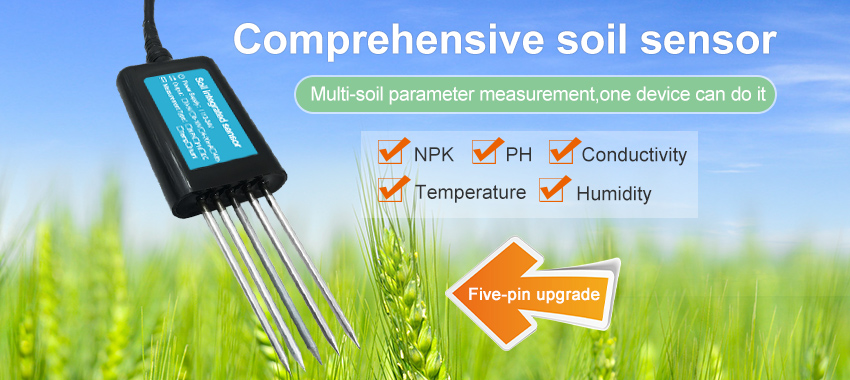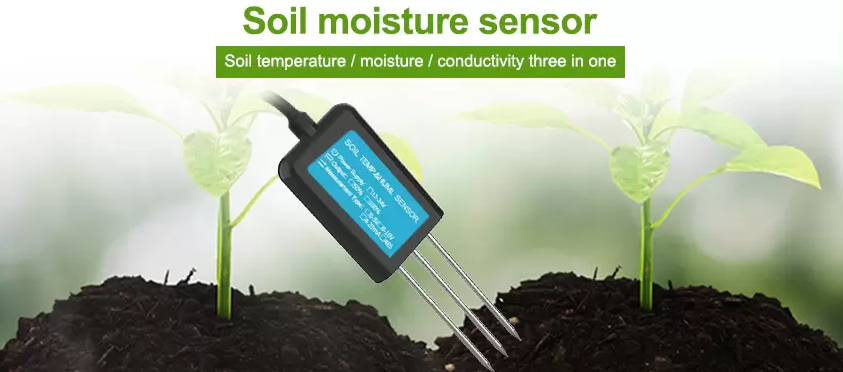Soil Sensors for Agriculture
In recent years, the development and adoption of advanced soil sensors for Agriculture have revolutionized the agricultural industry. These innovative devices enable farmers to monitor and manage soil conditions with unprecedented precision, leading to improved crop productivity, resource efficiency, and sustainability.

Importance of Soil Monitoring for Agriculture:
Soil is the foundation of agriculture, influencing plant growth, nutrient availability, water holding capacity, and overall soil health. Effective soil monitoring allows farmers to:
Optimize Nutrient Management: Soil sensors provide real-time data on essential nutrients, such as nitrogen, phosphorus, and potassium, enabling farmers to precisely adjust fertilizer application rates. This optimization minimizes nutrient waste, reduces environmental pollution, and improves crop uptake efficiency.

Manage Irrigation: Soil moisture sensors help farmers determine optimal irrigation schedules by measuring soil water content and monitoring changes over time. This information ensures that plants receive adequate water without wasting resources through over-irrigation, thus improving water-use efficiency and conserving water.
Prevent Soil Erosion: By monitoring soil moisture and compaction levels, farmers can implement appropriate soil conservation practices, such as cover cropping and reduced tillage. These practices help prevent soil erosion, enhance soil structure, and preserve soil fertility, ultimately improving long-term agricultural sustainability.
Enhance Precision Agriculture: Advanced soil sensors are a crucial component of precision agriculture, enabling site-specific management of farms. By mapping soil variability across fields, farmers can tailor inputs, such as seed, fertilizer, and irrigation, to specific soil conditions, optimizing resource allocation and maximizing crop yield.
Key Features of Advanced Soil Sensors for Agriculture
Advanced soil sensors incorporate various technologies and features that enhance their functionality and accuracy:
Multiple Parameter Measurement: These sensors can measure multiple soil parameters simultaneously, including soil moisture, electrical conductivity, pH level, temperature, nutrient levels, and organic matter content. This comprehensive data enables a holistic understanding of soil conditions and facilitates informed decision-making.
Wireless Connectivity: Many advanced soil sensors are equipped with wireless connectivity options, allowing seamless data transmission to central monitoring systems or mobile devices. This feature enables real-time data access, remote monitoring, and integration with other precision agriculture technologies.
High Accuracy and Reliability: Advanced soil sensors utilize cutting-edge sensor technologies, such as capacitance, time domain reflectometry, or electromagnetic induction, to provide highly accurate and reliable measurements. These sensors are calibrated to minimize measurement errors and ensure precise data collection.
Data Logging and Analysis: Most advanced soil sensors have built-in data logging capabilities, storing measurements over time. This historical data is valuable for analyzing trends, identifying patterns, and making data-driven decisions regarding soil management practices.
Ease of Installation and Use: These sensors are designed for easy installation and use, with user-friendly interfaces and intuitive calibration processes. This ensures that farmers, regardless of their technical expertise, can adopt and benefit from advanced soil sensing technologies.
Applications of Advanced Soil Sensors in Agriculture
Advanced soil sensors find diverse applications in modern agriculture, contributing to improved productivity, resource efficiency, and sustainability:
Precision Irrigation Management: Soil moisture sensors enable precise irrigation scheduling by providing real-time information on soil water content. Farmers can adjust irrigation rates based on actual plant needs, resulting in optimal water use, reduced energy consumption, and minimized nutrient leaching.
Nutrient Management and Fertilizer Optimization: Soil sensors help farmers optimize fertilizer application by monitoring soil nutrient levels. This allows for site-specific nutrient management, reducing over-application and preventing nutrient runoff into water bodies, which can lead to ecological damage.
Soil Health Assessment: Advanced soil sensors provide insights into soil health parameters, such as organic matter content, electrical conductivity, and pH level. This information helps farmers evaluate soil fertility, measure the effectiveness of soil conservation practices, and implement appropriate soil amendments.
Crop Disease and Pest Management: Soil sensors can detect changes in soil conditions that may indicate the presence of crop diseases or pests. By monitoring soil temperature, moisture, and other factors, farmers can take timely preventive measures, such as adjusting irrigation or applying targeted treatments, to minimize crop losses.
Environmental Monitoring: Advanced soil sensors support environmental monitoring efforts by detecting soil contamination, such as heavy metal accumulation or pesticide residues. Early detection allows for prompt actions to mitigate risks, protect groundwater quality, and ensure safe food production.
Conclusion:
Advanced soil sensors have transformed agriculture by providing accurate, real-time measurements of soil parameters critical for optimal crop growth and resource management. These devices enable precise irrigation scheduling, nutrient management, and soil health assessment, leading to improved productivity, resource efficiency, and environmental sustainability. By adopting advanced soil sensing technologies, farmers can make informed decisions, optimize input use, enhance crop yields, and contribute to a more sustainable future for agriculture. As the agricultural industry continues to face challenges related to climate change, water scarcity, and environmental degradation, advanced soil sensors will play a crucial role in addressing these issues and securing food production for a growing global population.